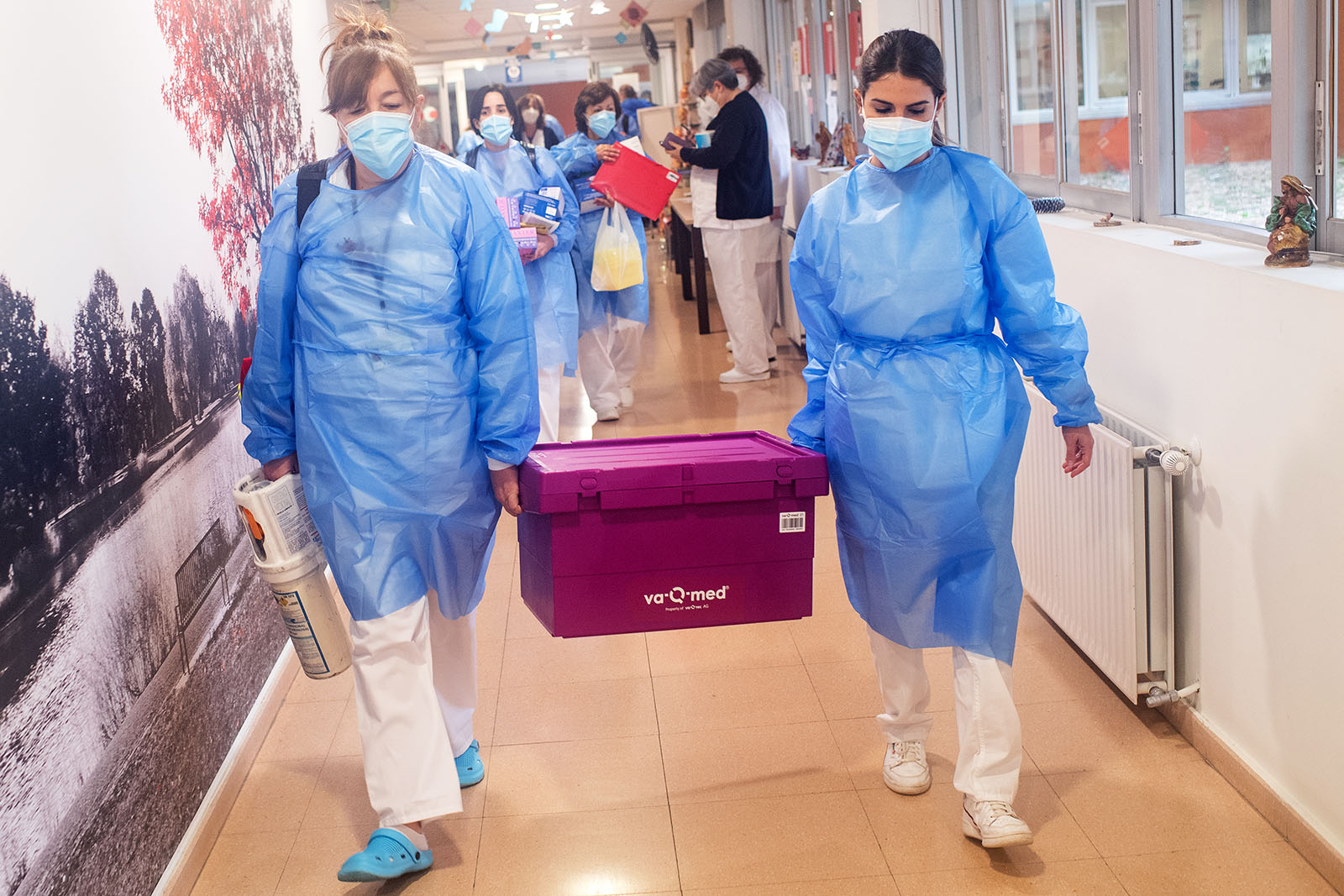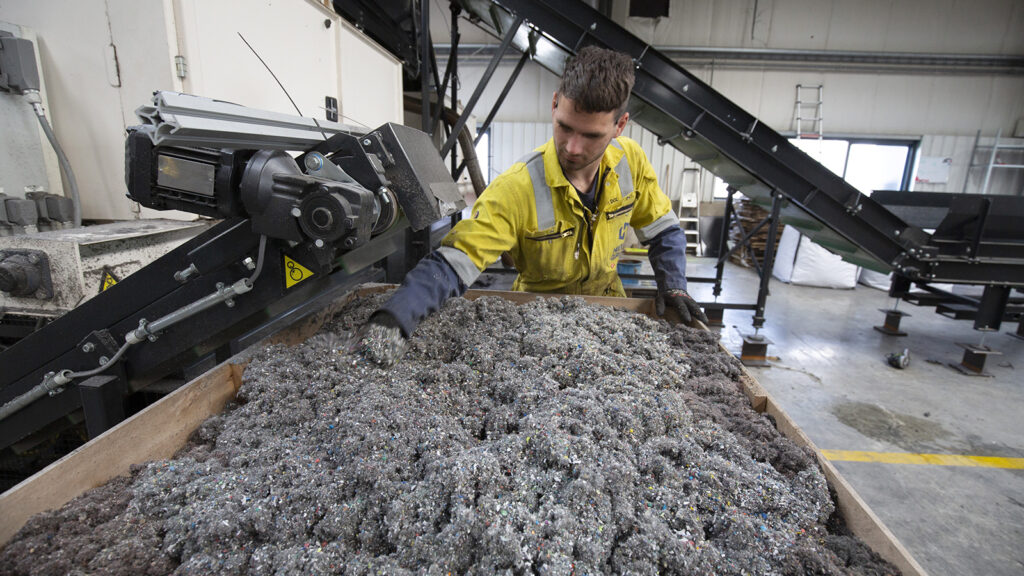How a COVID-19 Vaccine Can Reach Billions of People

Health care professionals transport some of the first doses of the COVID-19 vaccine in Spain. To keep the vaccine cold after arrival, vaccination centers will need new equipment and specially trained staff.
Photo: David Ramos/Getty Images
As the scientific obstacles to developing a COVID-19 vaccine recede, the logistical hurdles to injecting it into the arms of billions of people worldwide are just beginning. The coronavirus vaccine developed by Moderna can be stored at standard refrigerator temperatures for up to a month. The vaccine announced by Pfizer and BioNTech, made from messenger RNA technology, will need to be kept at about minus 75 degrees Celsius, thawed and injected within five days — or else re-iced in under one minute — or it will go bad. That is much lower than the temperatures most frozen vaccine supply chains operate at and much more complex.
A Subzero Supply Chain
The extra refrigeration means governments, companies and health systems have to forge a new subzero supply chain — or wait and gamble on the effectiveness of other vaccines that are protein-based and do not need to be kept at such low temperatures. Developing such a deep-freeze storage, delivery and application network for the OECD’s 37 countries would cost billions of dollars. Even then, that’s a fraction of the total funds required.
The greater challenge is managing the last-mile logistics and training staff for the tasks needed at scale at each stage. If anything goes wrong anywhere in the chain, that will stop the vaccine — which is scarce and costly — from surviving the pathway to its injection. To keep the vaccine cold after arrival, vaccination centers will need new equipment, specially trained staff and a process as smooth, coordinated and error-free as automotive production.
Though plans are still being drawn up, reports suggest that Germany could have more than 100 centers, which will inject 30 people every minute, 10 hours a day, 22 days a month. This would continue for the six months or so to achieve sufficient immunity in the population.
That said, it can be done. Vast, one-off distribution operations have been successfully mobilized globally in the past — to deliver millions of new iPhone models in days and Harry Potter books in hours. The differences: The COVID-19 vaccine requires fragile cold storage and transportation; the supply chain will run for months and not a single day; specially trained staff need to administer the vaccine; and millions of people will have to line up in the right position at the right time — twice.
Here’s how getting the vaccine to billions of people globally could work.
A Global Network of Vaccination Centers
The first step to drawing up a deep freeze road map for the vaccine is to set up the simplest pathway to as many people as possible. Most hospitals will not be equipped to handle thousands of people arriving and leaving every day, as they are set up more for individual care of a few patients. But governments, companies, and health systems can organize vaccination networks now in large facilities located near where many people live and can reach them easily by public or private transportation.
Germany’s 100 or more such vaccination centers will be planned for a population of about 80 million. They will likely be set up in locations that can accommodate the flow of tens of thousands of people every day, arriving and departing by car or public transport. In sparsely populated rural regions, smaller centers will be needed, too, as people will not be able to travel to a large center near a city.
Vaccination Centers and Herd Immunity
If herd immunity in OECD countries is achieved by having around 70% of their populations immune, about 500 vaccination centers would be required in major cities, 1,000 in small cities, and hundreds in rural areas. North America could achieve 70% immunity if it set up around 200 centers in major cities, 300 in small cities and nearly 400 centers in rural areas. Europe could reach the same level of immunity with almost 100 urban centers, 200 in small cities and around 100 in rural areas.
Success in the distribution process of a COVID vaccine will require structured end-to-end planning, just-in-time delivery and relentless administration.
But many more facilities would be required in Asia, because of its large population, much of which lives in sparsely populated areas without efficient transport links. To make only 46% of the population in Asia immune would require more than 1,000 vaccination centers in major cities, 1,000 in small cities and nearly 7,000 in rural areas. Forty-two percent immunity in Africa would require more than 300 vaccination centers in major cities, nearly 400 in small cities and more than 2,000 in rural areas. To get to 70%, these numbers would need to be 30% to 40% higher in Asia and Africa. In total, Asia and Africa will need 15 to 20 times as many distribution centers as OECD countries due to the sheer volumes of the vaccine that will need to be distributed across vast rural areas.
Deep Freeze Equipment and Trained Staff
After countries determine where the vaccines should be delivered, they have to distribute the dry-ice equipment required to keep the vaccines cold after arrival. Because they cannot risk the doses getting warm, they will need two dry-ice machines — one to act as backup. Typically, the machines cost about $40,000-$80,000 each, plus $40,000 for three months of liquid carbon dioxide, according to reports.
Training will also have to be organized. On top of doctors and nurses working in shifts to carry out the maximum number of daily injections, other staff must be in place to keep the vaccines cold — perhaps five per center, working in shifts. People will need to be trained and certified so that they can use the dry-ice machines and handle the vaccine doses in a way that keeps them cold. Staff will need training to administer the flow of people — all of whom must arrive for two injections, three weeks apart. Hospital backup must be planned in case of medical complications during a vaccination.
Secure Transportation of the Vaccine
Finally, companies, governments and health systems will need to be vigilant in order to guarantee that the vaccines will safely reach their destinations.
Breakdowns in temperature control at transport connections cannot be allowed to happen. Pfizer suggests passive cooling for transportation, using dry ice, which would mean the vaccine has to be administered within five days of leaving the factory. That means a process of continuous delivery that adjusts based on vaccines administered will be important.
This should be possible — but if there’s any delay, the vaccine will have to be re-iced, which will need people familiar with the process. So Pfizer has said it plans to take vaccine doses straight from the factory to vaccination centers without repackaging by using express delivery networks and air cargo. This skips the problem of re-icing during intermediate stops on long-haul journeys.
Breakthrough Logistics for a Breakthrough Vaccine
Meeting each of these conditions along a subzero supply chain is challenging. But none of them is impossible. Naysayers have been proven wrong that pharmaceutical companies could break through the scientific challenges involved in developing a COVID-19 vaccine within months. Now, it looks possible for companies, governments, and health systems to overcome the series of obstacles related to timing, planning and financing the distribution of the vaccine worldwide.
Success will require structured end-to-end planning, just-in-time delivery and relentless administration. Above all, we need patience from all of us who likely will need to queue for hours at one of the vaccination centers.








